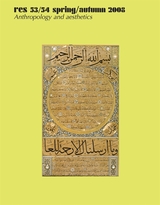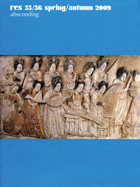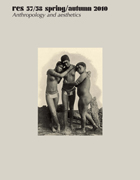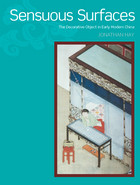4 books by Hay, Jonathan

Res
Anthropology and Aesthetics, 53/54: Spring and Autumn 2008
Francesco Pellizzi
Harvard University Press, 2008
This double volume includes: The value of forgery, Jonathan Hay; Affective operations of art and literature, Ernst van Alphen; Betty’s Turn, Stephen Melville; Richard Serra in Germany, Magdalena Nieslony; Beheadings and massacres, Federico Navarrete; Pliny the Elder and the identity of Roman art, Francesco de Angelis; Between nature and artifice, Francesca Dell’Acqua; Narrative cartographies, Gerald Guest; The artist and the icon, Alexander Nagel; Preliminary thoughts on Piranesi and Vico, Erika Naginski; Portable ruins, Alina Payne; Istanbul: The palimpsest city in search of its archi-text, Nebahat Avcioglu; The iconicity of Islamic calligraphy in Turkey, Irvin Cemil Schick; The Buddha’s house, Kazi Khalid Ashraf; A flash of recognition into how not to be governed, Natasha Eaton; Hasegawa’s fairy tales, Christine Guth; The paradox of the ethnographic-superaltern, Anna Brzyski, and contributions to “Lectures, Documents and Discussions” by Karen Kurczyncki, Mary Dumett, Emmanuel Alloa, Francesco Pellizzi, and Boris Groys.
[more]

Res
Anthropology and Aesthetics, 55/56: Absconding
Francesco Pellizzi
Harvard University Press, 2009
This volume includes the editorial “The absconded subject of Pop,” by Thomas Crow; “Enlivening the soul in Chinese tombs,” by Wu Hung; “On the ‘true body’ of Huineng,” by Michele Matteini; “Apparition painting,” by Yukio Lippit; “Immanence out of sight,” by Joyce Cheng; “Absconding in plain sight,” by Roberta Bonetti; “Ancient Maya sculptures of Tikal, seen and unseen,” by Megan E. O’Neil; “Style and substance, or why the Cacaxtla paintings were buried,” by Claudia Brittenham; “The Parthenon frieze,” by Clemente Marconi; “Roma sotterranea and the biogenesis of New Jerusalem,” by Irina Oryshkevich; “Out of sight, yet still in place,” by Minou Schraven; “Behind closed doors,” by Melissa R. Katz; “Moving eyes,” by Bissera V. Pentcheva; “‘A secret kind of charm not to be expressed or discerned,’” by Rebecca Zorach; “Ivory towers,” by Richard Taws; “Boxed in,” by Miranda Lash; “A concrete experience of nothing,” by William S. Smith; “Believing in art,” by Irene V. Small; “Repositories of the unconditional,” by Gabriele Guercio; “From micro/macrocosm to the aesthetics of ruins and waste-bodies,” by Jeanette Zwingenberger; “Are shadows transparent?” by Roberto Casati; “Invisibility of the digital,” by Boris Groys; “Des formes et des catégories,” by Remo Guidieri; and “Further comments on ‘Absconding,’” by Francesco Pellizzi.
[more]

Res
Anthropology and Aesthetics, 57/58: Spring/Autumn 2010
Francesco Pellizzi
Harvard University Press, 2010
This double volume of the renowned international journal of anthropology and comparative aesthetics includes “Aesthetics’ non-recyclable ground” by Félix Duque; “Seeing through dead eyes” by Jonathan Hay; “The hidden aesthetic of red in the painted tombs of Oaxaca” by Diana Magaloni; “A consideration of the quatrefoil motif in Preclassic Mesoamerica” by Julia Guernsey; “Hunters, Sufis, soldiers, and minstrels” by Cynthia Becker; “Figures fidjiennes” by Marc Rochette; “A sacred landscape” by Rachel Kousser; “Military architecture as a political tool in the Renaissance” by Francesco Benelli; “The icon as performer and as performative utterance” by Marie Gasper-Hulvat; “Image and site” by Jas’ Elsner; “Untimely objects” by Ara H. Merjian; “Max Ernst in Arizona” by Samantha Kavky; “Form as revolt” by Sebastian Zeidler; “Embodiments and art beliefs” by Filippo Fimiani; “The theft of the goddess Amba Mata” by Deborah Stein; and contributions to “Lectures, Documents and Discussions” by Gottfried Semper, Spyros Papapetros, Erwin Panofsky, Megan R. Luke, Francesco Paolo Adorno, and Remo Guidieri.
[more]

Sensuous Surfaces
The Decorative Object in Early Modern China
Jonathan Hay
Reaktion Books, 2010
?Sensuous Surfaces is a systematic introduction to the decorative arts in Ming and Qing dynasty China. Jonathan Hay’s analysis takes in both material and technique, and also issues of patronage and taste, which together formed a loose system of informal rules that affected every level of decoration in early modern China, from an individual object to the arrangement of an entire residential interior. By engaging the actual and metaphoric potential of surface, this system guided the production and use of the decorative arts during a period of explosive growth, which started in the late sixteenth century and continued until the mid-nineteenth century. The system made a fundamental contribution to the sensory education of China’s early modern urban population, both as individuals and in their embodiment of established social roles. Sensuous Surfaces is also a meditation on the role of pleasure in decoration. Often intellectually dismissed as merely pleasurable, Hay argues that decoration is better understood as a necessary form of art which can fulfil its function only by engaging the human capacity for erotic response. Featuring around 280 colour images, of a wide range of early modern Chinese objects and art-works, this book will engage anyone with an interest in decoration, art, China – or the experience of pleasure itself.
[more]
READERS
Browse our collection.
PUBLISHERS
See BiblioVault's publisher services.
STUDENT SERVICES
Files for college accessibility offices.
UChicago Accessibility Resources
home | accessibility | search | about | contact us
BiblioVault ® 2001 - 2024
The University of Chicago Press









